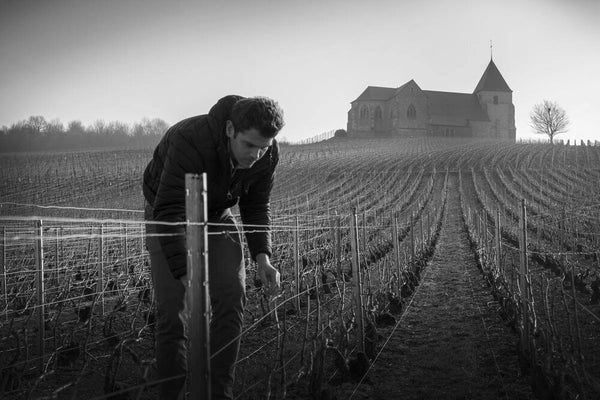
Champagne Tellier
The story of the Champagne Tellier estate dates back to 1222, when the story of the Lords of Les Conardins in the Champagne region began. The last remaining lord of the farm, Pierre-Louis de Failly, who died in 1792, is known to have produced sparkling wines on the farm. After the French Revolution, Château des Conardins was sold and the castle buildings were finally burned down. Since then, the farm has had several owners, who, like the Lords, did not leave a significant mark on the history of the farm. However, everything changed when Raymond Renaud bought Domaine des Conardins in 1936. Renaud modernized the farm's winemaking equipment and expanded the farm's orchards. From 1980, Christophe Tellier continued the work started by Reynaud and began to create something suitable for the next generation. Christophe's son Quentin joined the family estate in 2016 and his younger brother Alexandre in 2020. With Quentin's involvement, the estate's first champagnes were created, and the story of the house began. The 2016 wines in Viinitie's selections are therefore something unprecedented by world standards!
Domaine Tellier is located near Epernay in Moussy, located between the Montagne de Reims and the Côte des Blancs. The shelter areas are located in five different villages in the middle of the slopes. In total, there are 7 hectares of paddocks in Moussy and Pierry, the area that forms the historic Conardins farm. In the 13 plots of these villages, Meunier is the king variety with a 59% share. Chardonnay is cultivated in 35% of the orchards and Pinot Noir in 6%. The bottom of the soil in the villages is typically limestone for the region, but the topsoil is deep, creating strong and richly structured wines. There are also 2 hectares of shelters in Chavot, Fontaine and Aÿ, as well as Cramant. These 4 plots grow pure Chardonnay with the soil being much thinner on the limestone subsoil, producing wines that are elegant and remarkably mineral.
The oldest vines on the farm were planted in 1964, and otherwise the average age of the orchards is about 35 years. In order to preserve the tradition of the nurseries, the new plantings are done with the help of selection massale. The orchards have been cultivated with sustainable methods from the beginning and as a result of Christophe's hard work, since 2016 the production has been HVE certified. However, this was not considered sufficient on the farm, so the conversion to organic production is underway.
Each of the farm's 18 plots has a unique story to tell related to history, soil, climate and cultivated varieties, so Quentin vinifies the plots separately in the Burgundian style. The entire harvest is done by hand when the grapes reach their full ripeness. After arriving at the farm, the grapes are gently pressed in a 6000 kg press. Only the most aromatic juice from the first pressing and the best ripening potential is used. The wine is protected with a neutral gas, so that sulfur dioxide does not have to be used. The juice is allowed to settle in a cool place without enzymes for 12-24 hours, when only the finest precipitate of the juice gives the future fermentation yeast the nutrients it needs. All the estate's wines are fermented with the help of natural yeast in demi-muid and foudre-sized oak barrels. For his oak, Quentin selected Northern French fine grain oak varieties from the Vosges, Nièvre and Allier forests. After fermentation, the base wines mature in their vessels for 8 months, during which the lees are occasionally mixed and the barrels are kept full, which protects the wine from premature oxidation. Clarifying agents, let alone sulfur dioxide, are not added to the base wine at this stage either.
Based on the results of continuous tasting, the separately vinified wine batches are either mixed together or made 100% as wines from one vineyard. All wines are wines from one vintage, in which case no reserve wine is used and the wines mirror the weather conditions of each vintage. The second fermentation of the wines takes place in cool cellars dating back to the Middle Ages and the 19th century. Each wine matures on the lees for a minimum of 36 months. Quentin believes that time best brings out the full potential of his wines, and is not only patient but also confident in his winemaking. Finally, during recorking, only a minimal amount of sugar is added to the wines, whereby all wines are classified as either Extra Brut or Brut.
In total, the estate produces 10 different wines, including 8 sparkling champagnes, 1 white wine and 1 red wine. The producer has the Haute Valeur Environnementale certificate.
Come and join us in creating a better wine culture
We at Viinitie believe that Finland is ready for a better wine culture. People are thirsty for quality, responsibility and stories in more and more glasses. That's why we want to be even more torchbearers of this cultural change and make better wines available to everyone.
Join the Viinitie Grand Crew community and you are involved in making a better wine culture.
Powered by Shopify © 2025, Viinitie Oy

